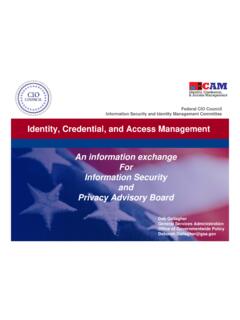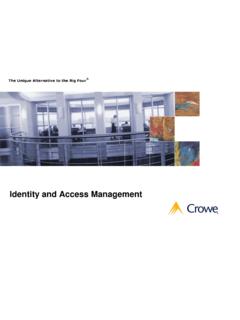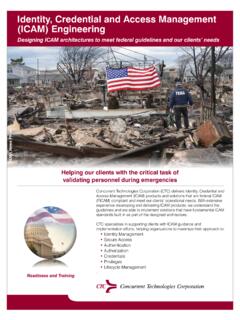Transcription of State Identity Credential and Access Management (SICAM ...
1 State Identity Credential and Access Management (SICAM). Guidance and Roadmap State Identity Credential and Access Management (SICAM) - Guidance and Roadmap Version September 2012. EXECUTIVE SUMMARY. The State Identity and Credential Access Management (SICAM) Guidance and Roadmap outline a strategic vision for State -based Identity , Credential , and Access Management efforts, and em- phasizes the importance of implementing the SICAM architecture and services in support of the challenges associated with trust, interoperability, security, and process improvement. States can, and should, provide a secure, auditable environment for the processing and ex- change of information across the entire spectrum of State business. SICAM is comprised of the programs, processes, technologies, and personnel used to create trusted digital Identity repre- sentations of individuals and/or Non-Person Entities (NPE).
2 This guidance promotes a federated approach where the identification of the information requester and supplier are guaranteed. This is of vital importance in an environment where phishing, scamming, and Identity theft are rampant. It is essential that State governments take the initiative to ensure the integrity of the data entrusted to them and provide a high level of security and privacy to citizens, customers, and partners. The SICAM architecture enables states and their partners to share and audit identification, au- thentication, and authorization across State enterprise boundaries. This will significantly reduce administrative and technological overhead caused by siloed, incompatible, and un-auditable Identity Management systems, lead to improved business processes and efficiencies, and reduce cyber security risk. There are multiple initiatives underway to address these challenges Personal Identity Verifica- tion (PIV) cards are being issued in increasing numbers, the Public Key Infrastructure (PKI) has connected government and commercial PKIs via a trust framework, working groups are tackling relevant process, technology and operational questions for mission-specific functions, and many others are leveraging digital identities to enable trusted government to citizen (G2C), govern- ment to business (G2B), and government to government (G2G) transactions.
3 The primary audience for the document is the State Chief Information Officer (CIO), State Chief Information Security Officer (CISO), State Enterprise Architect (EA) and other State ICAM imple- menters at all stages of program planning, design, and implementation; however, the document may also be used as a resource for systems integrators, end users, other entities, and commer- cial business partners seeking interoperability or compatibility through State programs. While this document serves to outline a common framework for SICAM in the State government, it is understood that agencies are at different stages in the implementation of their SICAM architec- tures and programs. As a result, they will need to approach alignment with SICAM from varying perspectives. The SICAM Guidance and Roadmap will also serve as an important tool for provid- ing awareness to external mission partners and drive the development and implementation of interoperable solutions.
4 This SICAM Guidance and Roadmap is being released as Version and may include revised content in future iterations. The document should be used for research purposes only and it has been acknowledged by the authors that use of content from other documents has been indicat- ed in the bibliography. State Identity Credential and Access Management (SICAM). I Guidance and Roadmap Document Overview The SICAM Guidance and Roadmap provides architectural direction for a statewide Identity man- agement framework and is organized into the following sections: Section 1 - Introduction: The introduction gives background information, provides the value proposition for the SICAM, and defines the document scope. Section 2 Goals and Objectives: The goals and objectives primarily focus on the role of the State government in achieving the SICAM end- State . Other key stakeholders have a crucial role in enabling interoperability and trust across the SICAM landscape to accomplish secure informa- tion sharing outside of State government boundaries.
5 Stakeholders, mentioned throughout this document, include citizens, external businesses and commercial entities wishing to conduct business with State governments; the health IT community as it increases its reliance on SICAM. activities in order to facilitate the use of e-health records; Federal/Emergency Response Offi- cial (F/ERO) emergency preparedness; and federal, local, and tribal governments that require information exchanges to meet mission needs. Section 3 Assurance Levels: The State Identity , Credential and Access Management Assurance Level Model is a tool for objectively assessing the ability of government to perform a project over the lifecycle of SICAM presence across the enterprise. The assurance model represents a flexible and adaptive approach toward identification of the current ICAM presence and the next steps to be considered for establishing assurance levels for the SICAM architecture solution.
6 Section 4 SICAM Principles, Processes and Concepts: This section introduces key principles and components that characterize SICAM architecture, but are not an exhaustive set of all the complexities that exist. Section 5 SICAM Architecture Framework: Development of the SICAM Architecture Frame- work provides the rules and definitions necessary for the integration of information and services at the conceptual level. The framework combines business and environment processes and rep- resents the blueprint for the implementation of the SICAM solution. The blueprint contains the details that are essential for allowing data to flow from agency to agency. Section 6 Approach to Implementation: This section outlines key strategies for meeting the targeted framework for SICAM. This section will also outline how interoperability will occur to share Identity attributes across department and agency boundaries, By breaking down boundar- ies, states can reduce the total cost of ownership for department an agency Identity systems.
7 Section 7 Summary: There are many steps along the way and an organization may find that not all of the areas fit neatly within the lines. Maturity within the architecture framework will vary across the business architecture processes and technology architecture, as well as the architecture blueprint. This is an evolving process for states and leads to an efficient, effective, and responsive development for Identity and Access Management solutions. Appendix A-K: Includes additions to the document that can be used as reference material on topics found within SICAM. Contents State Identity Credential and Access Management (SICAM). II Guidance and Roadmap Acknowledgements NASCIO would like to express its thanks and gratitude to the members of the 2012 State Digital Identity Working Group for lending their time and expertise to help guide this pub- lication's development.
8 NASCIO would also like to extend a special thank you to former members of the State Digital Identity Working Group who made it possible for this group to continue down the path towards developing the first version of the State Identity Credential and Access Management Guidance and Roadmap. Finally, NASCIO extends a special thanks to those State CIOs and their staff who contributed in the development and revision of this product. Please direct any updates, questions or comments about this publication or any of NASCIO's State Digital Identity Working Group research products to Chad Grant at or call (859) Founded in 1969, the National Association of State Chief Information Officers (NASCIO). represents State chief information officers and information technology executives from the states, territories, and the District of primary State government members are senior officials who have executive level and statewide responsibility for information tech- nology leadership.
9 State officials who are involved in agency level information technology Management may participate as associate members. Representatives from other public sec- tor and non-profit organizations may also participate as associate members. Private sector firms may join as corporate members and participate in the Corporate Leadership Council. AMR Management Services provides NASCIO's executive staff. Disclaimer NASCIO makes no endorsement, express or implied, of any products, services or web sites contained herein, nor is NASCIO responsible for the content or activities of any linked web sites. Any questions should be directed to the administrators of the specific sites to which this publication provides links. All information should be independently verified. State Identity Credential and Access Management (SICAM). III Guidance and Roadmap EXECUTIVE SUMMARY.
10 II. DOCUMENT OVERVIEW ..III. ACKNOLEDGEMENTS ..IV. 1. INTRODUCTION ..1. BACKGROUND ..1. VALUE PROPOSITION ..4. SCOPE ..6. ICAM DEFINITIONS ..7. Identities and credentials ..7. Identity Management ..8. Credential Management ..11. Access Management ..11. 2. GOALS AND OBJECTIVE ..13. GOAL 1: TRUST ..13. GOAL 2: INTEROPERABILITY ..15. GOAL 3: SECURITY(IMPROVE SECURITY POSTURE ACROSS THE State ENTERPRISE) ..16. GOAL 4: PROCESS IMPROVEMENT (FACILITATE E-GOVERNMENT BY STREAMLINING Access . TO SERVICES) ..17. HOW THE GOALS AND OBJECTIVES SHOULD BE USED ..18. 3. ASSURANCE LEVELS AND THE SICAM ASSURANCE LEVEL MODEL ..18. LEVEL 1 ..18. LEVEL 2 ..19. LEVEL 3 ..19. LEVEL 4 ..19. ASSURANCE LEVEL MODEL ..20. HOW TO USE THE SICAM ASSURANCE LEVEL MODEL ..20. 4. SICAM PRINCIPLES, PROCESSES AND CONCEPTS ..21. IMPLIED ARCHITECTURAL PRINCIPLES ..21. PROCESS AREAS FOR Identity MANAGENT.










